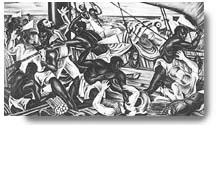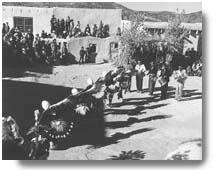Turkey on the Grill
Turkey on the Grill

All over America as the turkeys begin their last waddle toward their day of glory, football fans lay in their Turkey Day Classic supplies, new cooks begin their weeklong fret, and old cooks begin thinking of something new to do.
If there's one day in the year when "ordering in" should be forbidden, this is it: Thanksgiving. A child's memory of Ma calling up the local caterer just doesn't make it - what if that kid becomes a novelist? Or worse yet, a filmmaker?
Better to bite the bullet and wrestle the project to the table.
Should the man of the house feel that the outdoor grill is his baby, by all means let him at it. There's plenty of work for all in making the stuffing, mashed potatoes, gravy (you have to buy a little chicken to make that if the turkey is grilled), and all the usual parts and attachments of the traditional Thanksgiving dinner. One way to avoid total exhaustion is to assign different dishes to various family members or guests - preferably, things to be made in their own kitchens and transported.
Turkey on the Grill
A 12 to 14-pounder is the top weight for this treatment: Otherwise the grill cover won't close. Do some pre-measuring of your grill before selecting your bird to be sure it fits. Two days in advance wash the turkey inside and out in cold running water. Dry it well with a ton of paper towels. Rub it inside and out with the following "dry rub," which is less demanding than a brine.
Dry Marinade "Rub":
1 Tbsp. dried juniper berries
1 Tbsp. coarse salt
1 tsp. allspice berries
2 tsp. whole black peppercorns
6 fresh sage leaves or 3 dried
3 large cloves garlic, peeled and minced
Grind the first five ingredients in a spice mill or combine with the finely minced garlic. Rub your turkey inside with some of the mixture. Lift the skin away from the breast and as much of the thighs as possible and rub them well with more of the dry marinade. Rub the remainder over the inside of the wings, which should be punctured with a small knife so that they can absorb the "rub."
Put the turkey in a plastic bag, tie it closed, and put it in the fridge. Turn the bag over at least once a day - twice is better - for the next two days. Then blot it dry, rub the bird all over with softened butter, duck fat, or oil, fasten down the neck skin in back with a small skewer, snap the wings behind its back, push the legs up toward the body, and tie the bird's ankles together. Cover the wings with foil.
Do not stuff. With this fast-roasting method, the stuffing might never even get hot and you'd be risking salmonella - yes, even turkeys carry it. Never roast a turkey by any method that requires more than three hours to get it to 140 degrees F. - sitting around at low temperatures is an invitation to food poisoning. Those Holly Golightly tales of cooking with a hair dryer or steaming stuff in a dishwasher are faintly cute at best, more often lethal. (Smoking is a "whole 'nother" project, not discussed here - it takes about 10 to 12 hours.)
Remove the cooking grill and open the bottom and top vents. Put two foil pans, one inside the other, in the center of the coals rack and put briquette racks on either side of it. Half fill the foil pans with water. Put about 30 briquettes on either side of the drip pan and light them. When they are covered with a light ash, put the top cooking rack in place and put the turkey, breast side up, on it directly over the the drip pan. Brush well with melted butter or oil.
Cover and roast, adding six or eight coals to either side of the drip pan every hour to maintain approximately 325 degrees inside the grill. With most grills this is impossible to ascertain exactly, so just try to keep it at medium-hot and take care it doesn't brown too fast (tent with foil if this seems to be happening).
A 12-pound turkey will require between two and three hours (much depends on the outside air temp, the wind factor, the heat maintained by your grill, the score of the football game), and the only way to tell if the bird is done is with a meat thermometer. Insert it into the thickest part of the thigh and when it reads 170 degrees remove the turkey to a warm carving board and let rest in a warm (not hot) place for 15 to 20 minutes to let the juices settle.
All grilled turkeys have a thin line of pink just under the skin, which is a reaction of the meat pigment. It is not underdone. The ball joints of the turkey will be a bit pink too, even in hot-smoked turkey that's been on for 12 hours, but it is not underdone.
Turkey on a Gas Grill
Prepare the turkey as outlined above, or, if you prefer, simply stuff the breast and as much of the thigh as is reachable underneath the skin with a mixture of fresh parsley and fresh sage or tarragon, salt, pepper, and butter. Rub the bird well with oil or softened butter and salt well.
On a dual-burner grill: Preheat 10 minutes with ceramic or lava stones in place and the drip pan half-filled with water on one side of the grill. Turn the heat to medium and place the turkey on the other side of the grill and close the cover. Be sure there's one inch clearance between the turkey's breast and the grill lid. The thigh temperature should read 170 F. when the turkey is done. Check the bird, particularly in the beginning, to regulate the cooking - if you see the skin turning black, you know you've gone too far - turn right and go out for dinner.
A 12-pound unstuffed turkey should be done in about two hours. Let it rest 20 minutes before carving.
On a triple-burner grill: Preheat the grill for 10 minutes, then turn off the center burner. Lower the heat to medium on the front and back burners (if using ceramic rocks they should be in place before heating). Put the turkey, breast up, on the well-greased cooking grate. Close the lid and try to regulate the heat at about 325 to 350 degrees F.
Watch closely in the beginning, but don't keep opening the grill lid or too much heat will escape. Mop with melted butter if the skin seems dry, but the fat won't penetrate very far, which is the reason for first spreading herb butter between the skin and flesh. The turkey is done when the deepest part of the thigh reaches 170 degrees. As the heat in a gas grill is more constant and reliable than in a charcoal grill, a 12-pound turkey is fairly certain to reach that temperature in two hours.
Super worriers roast their birds to 180 or even 200 degrees, which dries them out. A large piece of meat continues to cook on residual heat for at least 15 minutes after it is removed from the heat source and normally reaches 180 in that time anyway.
Now isn't that perfect? Having the turkey cooked outside and the kitchen free for all the other fixings . . . don't worry, plenty of delicious aromas will fill the house from the stuffing and gravy and all the other umpteen things we add to our annual Super Feast.



